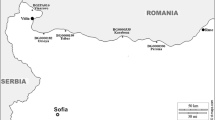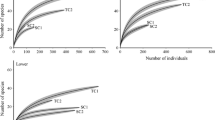Abstract
Bajadas are transition zones between the foothills of the mountainous areas and the valleys in the arid zones of North America; given their microclimatic characteristics (geomorphological composition, high humidity, and low solar radiation) they are probably a refuge for many plant species; however, there are no reports for the bajadas in the Cuatro Ciénegas Basin. This work describes the structure, composition, and diversity of the plant community found in bajadas in the Cuatro Ciénegas Basin (CCB) in the Chihuahuan desert, where we sampled 0.6 ha. We found 38 plant species, 26 genera, and 11 families. The Shannon diversity index was 3.2, higher than those registered in other arid zones. The Cactaceae family includes the greatest number of species (22 species), seven of them are classified under some threat category; other cacti species had a restricted distribution into the so-called mega Coahuilan region. The most important species based on their density and volume were: Grusonia bradtiana (importance value, IV =35.3%), Larrea tridentata (IV=15.9%), and Jatropha dioica (IV=14.12%), these species might strongly contribute to the composition of bajadas since they function as nurse plants for other plant species. As the CCB is one of the most diverse of the Chihuahuan Desert, the knowledge of the diversity, structure, and composition of bajadas is relevant to define important sites and strategies for the conservation of North America’s largest desert.
Access this chapter
Tax calculation will be finalised at checkout
Purchases are for personal use only
Similar content being viewed by others
References
Arias S, Guzmán U, Mandujano MC, Galván S et al (2005) Las especies de cactáceas mexicanas en riesgo de extinción. I. Una comparación entre los listados NOM-059-ECOL-2001 México, La Lista Roja (UICN) y CITES. Cact. Suc. Mex 50:100–125
Bowers MA, Lowe CH (1986) Plant-Form Gradients on Sonoran Desert Bajadas. Oikos 46:284–291
Colwell RK (2013) Estimates: Statistical estimation of richness species and shared species from samples. Version 9. Persistent URL purl.oclc.org/estimates
Curtis JT, McIntosh RP (1950) The interrelations of certain analytic and synthetic phytosociological characters. Ecology 31:434–445
Ezcurra E, Martínez-Berdeja A, Villanueva-Almanza L (2020) The evolution of North American deserts and the uniqueness of Cuatro Ciénegas. In: Mandujano MC, Pisanty I, Eguiarte L (eds.) Plant diversity and Ecology in the Chihuahuan desert. Springer International, Cham, Switzerland
Ferrusquia-Villafranca I, González Gúzman LI, Cartron JL (2005) Northern Mexico’s landscape, Part I: The physical setting and constrains on modeling biotic evolution. In: Cartron JL, Ceballos G, Felger RS (eds) Biodiversity, Ecosystems and Conservation in Northern México. Oxford University Press, Oxford, UK, pp 11–38
Henrickson J, Johnston MC (2007) A flora of the Chihuahuan Desert Region. Published by J. Henrickson, Los Angeles, p 1695
Hernádez HM, Goettsch B, Gómez-Hinostrosa C et al (2008) Cactus species turnover and diversity a long a latitudinal transect in the Chihuahuan Desert Region. Bio Conser 17:703–720
Hernández HM, Gómez-Hinostrosa C, Goettsch B (2004) Checklist of Chihuahuan Desert Cactaceae. Harvard Paper Botany 9(1):51–68
Krebs CJ (1999) Ecological Methodology. Addison Wesley Longman, Inc, Menlo Park, CA, USA
MacMahon JA (1979) North American deserts: their floral and faunal components. In: Goodall DW, Perry RA (eds) Arid-Land Ecosystems: Structure, Functioning and Management, IBP 16, vol 1. Cambridge University Press, Cambridge, UK, pp 21–82
Martínez-Ávalos JG, Martínez-Gallegos R, Guerra-Pérez A, Torres Castillo JA, et al. (2020). Diversity and distribution of cacti species in the Cuatro Ciénegas basin. In: Mandujano MC, Pisanty I, Eguiarte L (eds.) Plant diversity and Ecology in the Chihuahuan desert. Springer International, Cham, Switzerland
Matteucci SD, Colma A (1982) Metodología para el estudio de la vegetación Secretaría General de la Organización de los Estados Americanos. Secretaria General de la Organización de los Estados Americanos. Programa Regional de Desarrollo Científico y Tecnológico, Washington, DC, USA
Montaña C (1990) A Floristic-Structural Gradient Related to Land Forms in the Southern Chihuahuan Desert. J Veg Scie. 1:669–674
Ochoterena H, Flores-Olvera H, Gómez-Hinostrosa C, Moore MJ (2020) Gypsum and Plant Species: A Marvel of Cuatro Ciénegas and the Chihuahuan Desert In: Mandujano MC, Pisanty I, Eguiarte LE (eds) Plant diversity and Ecology in the Chihuahuan desert. Springer International, Cham, Switzerland
Phillips DL, MacMahon JA (1978) Gradient analysis of a Sonoran Desert bajada. The South Nat 23:669–680
Pinkava DJ (1984) Vegetation and flora of the Bolson of Cuatro Ciénegas Region, Coahuila, Mexico: IV. Summary, endemism and corrected catalogue. J Ariz Nev Acad Sci 19:23–47
Plascencia-López L, Rojas-Aréchiga M, Mandujano MC (2020) Reproductive Biology of Grusonia bradtiana (Cactaceae): a dominant species and endemic clonal Cactus from Cuatro Ciénegas Basin and contiguous areas in the Chihuahuan Desert. In: Mandujano MC, Pisanty I, Eguiarte LE (eds) Plant diversity and Ecology in the Chihuahuan desert. Springer International, Cham, Switzerland
Reyes Agüero JA, Aguirre Rivera JR, Peña Valdivia CB (2000) Biología y aprovechamiento de Agave lechuguilla Torrey. Bol. Soc. Bot. México 67:75–88
Rosas-Barrera MD, Golubov J, Pisanty I, Mandujano MC (2020) Effect of reproductive modes on the population dynamics of an endemic cactus from Cuatro Ciénegas In: Mandujano MC, Pisanty I, Eguiarte LE (eds) Plant diversity and Ecology in the Chihuahuan desert. Springer International, Cham, Switzerland
Scheinvar E, Gámez N, Castellanos-Morales G et al (2017) Neogene and Pleistocene history of Agave lechuguilla in the Chihuahuan Desert. J Biogeo 44:322–334
Scheinvar E, Gámez N, Moreno-Letelier A, Aguire-Planter E, Eguiarte L (2020). Phylogeography of the Chihuahuan Desert: diversification and evolution over the Pleistocene. In: Mandujano MC, Pisanty I, Eguiarte L (eds.) Plant diversity and Ecology in the Chihuahuan desert. Springer International, Cham, Switzerland
semarnat (2010) Secretaría de Medio Ambiente y Recursos Naturales. 2010. Norma Oficial Mexicana nom-059-semarnat-2010. Published on December 30, 2010 in Diario Oficial de la Federación, México, DF, Mexico
Silva-Montellano A, Eguiarte LE (2003) Geographic patterns in the reproductive ecology of Agave lechuguilla (Agavaceae) in the Chihuahuan desert. I. floral characteristics, visitors, and fecundity. Amer J Bot 90:377–387
Silvertown J, Wilson JB (1994) Community Structure in a Desert Perennial Community. Ecology 75:409–417
Souza V, Olmedo-Álvarez G, Eguiarte LE (eds) (2018) Cuatro Ciénegas Ecology, Natural History and Microbiology. Springer International, Cham, Switzerland
Stein RA, Ludwig JA (1979) Vegetation and Soil Patterns on a Chihuahuan Desert Bajada. Am Midl Nat 101:28–37
Villareal-Quintanilla JA (2001) Listados Florísticos de México, Flora de Coahuila XXIII. Instituto de Biología UNAM, México, DF, Mexico
Villarreal-Quintanilla JA, Bartolomé-Hernández JA, Estrada-Castillón E, Ramírez-Rodríguez H, Martínez-Amador SJ (2017) El elemento endémico de la flora vascular del Desierto Chihuahuense, The endemic element of the Chihuahuan Desert vascular flora. Act. Bot Mex. 118:56–96
Zavala-Hurtado JA, Jiménez M (2020). Diversity and uniqueness at its best. Vegetation of the Chihuahuan Desert. In: Mandujano MC, Pisanty I, Eguiarte L (eds.) Plant diversity and Ecology in the Chihuahuan desert. Springer International, Cham, Switzerland
Acknowledgments
We thank the APFF Cuatro Ciénegas (CONANP) office and the people in charge. We thank the owners of Rancho Orozco, Juan Manuel González and Alfonso González. This contribution is in partial fulfillment of the Graduate Program of Ciencias Biomédicas, Universidad Nacional Autónoma de México (UNAM) of the first author MSc. Juan Carlos Flores Vázquez, who also acknowledges the scholarship and financial support provided by the National Council of Science and Technology (CONACyT), fellowship 176604. To Valeria Souza for her hospitality in Cuatro Ciénegas and Carlos Slim Foundation. To Marco A. Romero Romero for helping with figures edition.
Author information
Authors and Affiliations
Corresponding author
Editor information
Editors and Affiliations
Rights and permissions
Copyright information
© 2020 Springer Nature Switzerland AG
About this chapter
Cite this chapter
Flores Vázquez, J.C., Rosas Barrera, M.D., Golubov, J., Sánchez-Gallén, I., Mandujano, M.C. (2020). Ecological Importance of bajadas in the Chihuahuan Desert. In: Mandujano, M., Pisanty, I., Eguiarte, L. (eds) Plant Diversity and Ecology in the Chihuahuan Desert. Cuatro Ciénegas Basin: An Endangered Hyperdiverse Oasis. Springer, Cham. https://doi.org/10.1007/978-3-030-44963-6_8
Download citation
DOI: https://doi.org/10.1007/978-3-030-44963-6_8
Published:
Publisher Name: Springer, Cham
Print ISBN: 978-3-030-44962-9
Online ISBN: 978-3-030-44963-6
eBook Packages: Biomedical and Life SciencesBiomedical and Life Sciences (R0)




